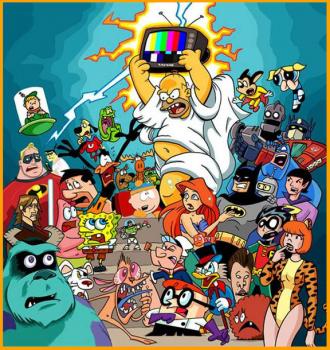
61. Same year, over at the University of Utah, Ed Catmull is working on developing an animation scripting language. His studies culminate in an animation of a smooth shaded hand. This allows him to later develop “tweening” software.
62. In either the same office, or a different one, still at the University of Utah, Fred Park creates the first computer generated facial animation.
63. All of this excitement of innovation in computers hikes up the national Research Council of Canada and they release “La Faim” (Hunger) directed by Peter Foldes featuring interactive key framing techniques.
64. Every so often, a little movie comes to the big screen that changes film history forever. In 1977, that movie was Star Wars. Larry Cuba produces Death Star simulation using Grass at UICC which was developed by Tom DeFanti.
65. The next year, Superman delights audiences with the first CGI film title.
66. Jim Blinn presents Voyage animation fly-by made specifically for NASA using Computer Graphics.
67. After a few years, a few films, at Disney Animation, Don Bluth leaves Disney taking about a third of the artists with him to set up his own studio.
68. George Lucas, director/genius behind Star Wars, takes notice of the innovation happening over at University of Utah and hires Ed Catmull, Ralph Guggenheim, and Alvy Ray Smith to form Lucasfilm after the success of Star Wars, Lucasfilm gives birth to a computer division in 1980.
69. The following year, the computer division makes another landmark move when in Star Wars: Episode VI: Return of the Jedi, they create a wire-frame “holographic” model of the Death Star under construction. Later this year, the computer division is separated into Games and Pixar.
70. Star Trek uses one minute for a “genesis effect” in “The Wrath of Khan” to make a dead planet come to life using fractals, particle effects, and a 32-bit RGBA paint software developed by Lucasfilm’s Pixar.
71. Three years later, in 1986, Steve Jobs buys it and it becomes Pixar. You may hear more about them… maybe.
72. The first film to use shaded 3D computer graphics is released in 1981’s “Looker”. It presents the virtual human character, Cindy.
73. One year later, Disney contracts Abel, III, MAGI, and DE for computer graphics for the movie “Tron.” At this time, very few companies understood this brand new CG thing, but the majority of the film was based inside a videogame. “Tron” was the first movie to incorporate visual effects but is ignored by the Motion Picture Academy of Arts and Sciences’ Visual Effects Branch for it’s leaps in the CG timeline. The box-office failure is suggested to be why the adoption of digital effects took so long to happen. Fast forward to 2002, what movie doesn’t have CG?
74. Animator, John Lasseter is fired from Walt Disney Animation Studios.
75. In 1984, instead of using typical molds and models in movies, “The Last Starfighter” uses CG.
76. Same year, Lucasfilm uses a Cray X-MP/48 and a cluster VAX 11/750s to create “The Adventures of Andre and Wally B” utilizing the newly fired talent of John Lasseter.
77. Shortly after Steve Jobs acquires Pixar, John Lasseter directs “Luxo Jr.” which is widely seen as the first computer animation to include believable character movement and personality. It is the first CGI film to be nominated for an Oscar… or well, for any award!
78. In 1986, Disney’s “The Great Mouse Detective” is the first animated feature to be aided by CG in the scene inside Big Ben.
79. Same year, Disney is successfully challenged by Don Bluth’s new Animation studio with the release of “An American Tail”.
80. John Lasseter believes in CG with all his heart, he publishes a paper describing traditional animation principles and how they can be translated into 3D Computer Animation.
